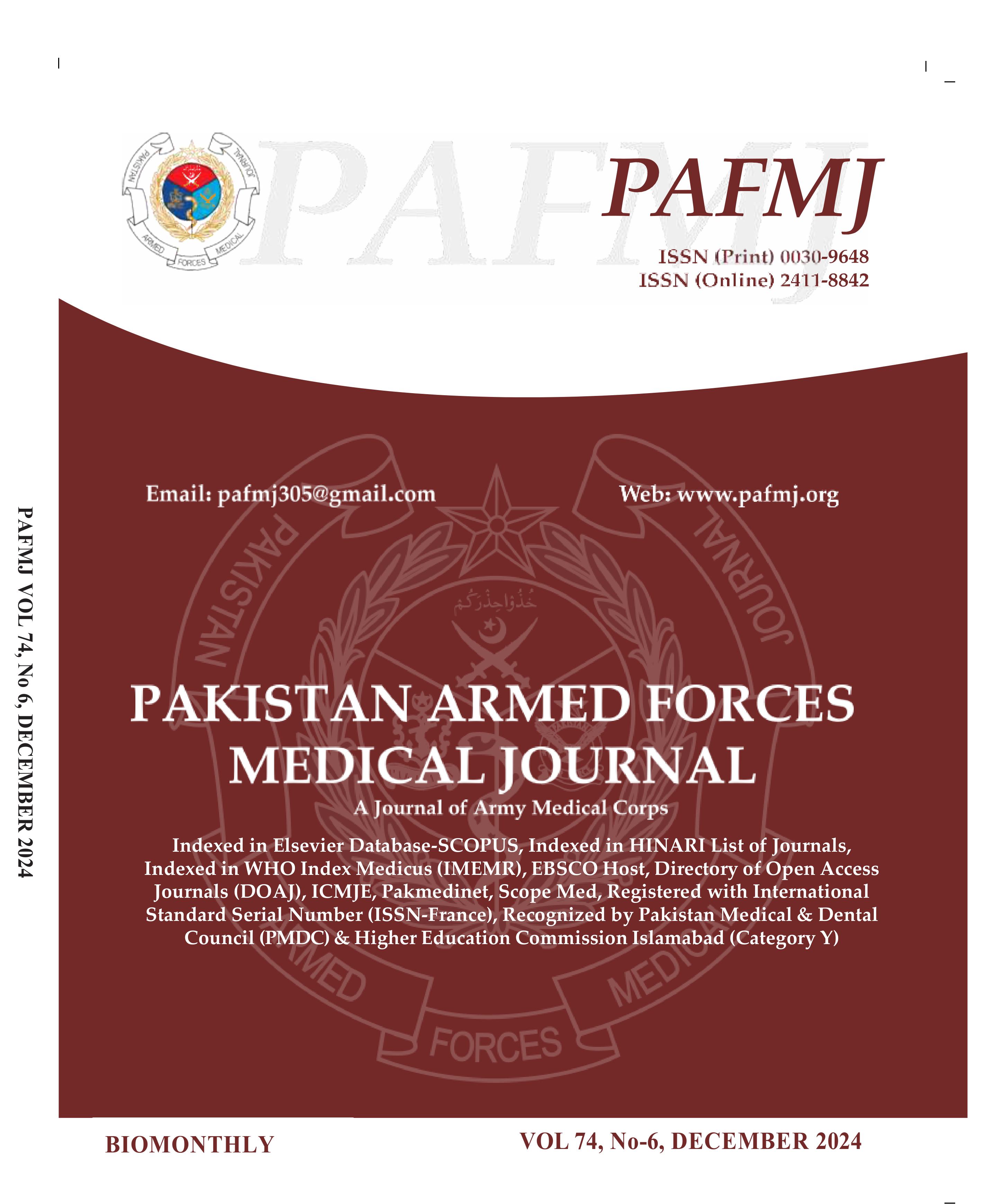Trends in Nosocomial Blood Stream Infection in PICU of a Tertiary Care Hospital
DOI:
https://doi.org/10.51253/pafmj.v74i6.9031Keywords:
Bloodstream infections, Community-acquired infections, Gram positive, Nosocomial.Abstract
Objective: To determine the local pathogens and antimicrobial sensitivity pattern in the Pediatric intensive care unit of Children Hospital Lahore and its impact on patients’ outcomes.
Study Design: Prospective longitudinal study.
Place and Duration of Study: Pediatric intensive care unit of Children Hospital, Lahore Pakistan from Feb 2021 to Feb 2022.
Methodology: All the children who were admitted to Pediatric intensive care unit during the study period were included; those having positive blood culture at admission, discharged, or who died within the 48 hours of admission were excluded. Blood cultures were sent after 48 hours of admission in patients having features suggestive of nosocomial BSI; those having positive blood cultures were considered to have nosocomial bloodstream infection(BSI) as per the definition of CDC. Demographic, microbiological, and other variables were documented.
Results: The mean age of patients was 3.0± 4.7 with age ranges from 1 month to 14 years 734(63.9%) were males and 423 (36.1%) were females. The bloodstream infection was confirmed by a positive blood culture report in 169(14.7%) patients. The normage of patients with BSI (n=169) was 1.6 ±6.04 and the average duration of stay of children with nosocomial BSI was 15.0± 39.97 (p-value < 0.001). The average days of mechanical ventilation in children with nosocomial BSI were 9.0±37.04 (p-value = 0.003). Among the
Conclusion: The frequency of nosocomial BSI in PICU is quite high, which in turn is associated with a longer duration of stay and poor outcomes. The emergence of highly resistant organisms,
Downloads
References
Tauhid SA, Chowdhury M, Hoque MM, Haque E. Nosocomial bloodstream infections in children in intensive care unit: organisms, sources, their sensitivity pattern, and outcome of treatment. J Bangladesh Coll Physicians Surg 2017; 35(3): 115-122. https://doi.org/10.3329/jbcps.v35i3.34341
Porto JP, Mantese OC, Arantase A, Freitas C, Filho PPG, Ribas RM. Nosocomial infections in a pediatric intensive care unit of a developing country: NHSN surveillance. Rev Soc Bras Med Trop 2012; 45(4): 475-479. https://doi.org/10.1590/S0037-86822012005000003
Hamid MH, Zafar A, Maqbool S. Nosocomial bloodstream infection in a tertiary care pediatric intensive care unit. J Coll Physicians Surg Pak 2007; 17(7): 416-419.
Pourakbari B, Rezaizadeh G, Mahmoudi S, Mamishi S. Epidemiology of nosocomial infections in pediatric patients in an Iranian referral hospital. J Prev Med Hyg 2012; 53: 204-206.
Prowle JR, Echeverri JE, Ligabo EV, Sherry N, Taori GC, Crozier TM, et al. Acquired bloodstream infection in the intensive care unit: incidence and attributable mortality. Crit Care 2011; 15(2): 100.
https://doi.org/10.1186/cc10114
Ferrer R, Loeches MI, Phillips G, Osborn TM, Townsend S, Dellinger RP, et al. Empiric antibiotic treatment reduces mortality in severe sepsis and septic shock from the first hour: results from a guideline-based performance improvement program. Crit Care Med 2014; 42(8): 1749-1755. https://doi.org/10.1097/CCM.0000000000000330
Richards MJ, Edwards JR, Culver DH, Gaynes RP. Nosocomial infections in pediatric intensive care units in the United States. Natl Nosocomial Infections Surveillance System. Crit Care Med 1999; 27(5): 887-892.
https://doi.org/10.1542/peds.103.4.e39
Ahmed SH, Daef EA, Badary MS, Mahmoud MA, AbdElsayed AA. Nosocomial bloodstream infection in intensive care units at Assiut University Hospitals with special reference to extended spectrum beta-lactamase producing organisms. BMC Res Notes 2009; 2: 76. https://doi.org/10.1186/1756-0500-2-76
Lakshmi KS, Jayashree M, Singhi S, Ray P. Study of nosocomial primary bloodstream infections in a pediatric intensive care unit. J Trop Pediatr 2007; 53(2): 87-92.
https://doi.org/10.1093/tropej/fml073
Parajuli NP, Parajuli H, Pandit R. Evaluating the trends of bloodstream infections among pediatric and adult patients at a teaching hospital of Kathmandu, Nepal: role of drug-resistant pathogens. Can J Infect Dis Med Microbiol 2017; 2017: 8763135.
https://doi.org/10.1155/2017/8763135
Cui J, Li M, Wang J. The incidence rate, species distribution and dynamic trends of bloodstream infection in China. Res Sq 2020. https://doi.org/10.21203/rs.3.rs-27335/v1
Rezk AR, Bawady SA, Omar NN. Incidence of emerging multidrug-resistant organisms and its impact on the outcome in the pediatric intensive care. Egypt Pediatr Assoc Gaz 2021; 69: 25. https://doi.org/10.1186/s43054-021-00071-1
Asanathong NW, Rongrungreung Y, Assanasen S. Epidemiology and trends of important pediatric healthcare-associated infections at Siriraj Hospital, Thailand. Southeast Asian J Trop Med Public Health 2017; 48(3): 641-654.
Ulus A, Kara SS, Çelik E. An evaluation of pediatric intensive care unit infection rates and various risk factors. Trends Pediatr 2020; 1(2): 75-80.
https://doi.org/10.5222/TP.2020.66376
Ayaz I, Hameed H, Amber W, Zafar T. Nosocomial bloodstream infections in pediatric intensive care unit of Fauji Foundation Hospital, Rawalpindi Pakistan. J Islamabad Med Dent Coll 2020; 9(4): 269-274.
https://doi.org/10.35787/jimdc.v9i4.533
Duan N, Sun L, Huang C. Microbial distribution and antibiotic susceptibility of bloodstream infections in different intensive care units. Front Microbiol 2021; 12: 792282.
https://doi.org/10.3389/fmicb.2021.792282
Canadian Nosocomial Infection Surveillance Program. Device-associated infections in Canadian acute-care hospitals from 2009 to 2018. Can Commun Dis Rep 2020; 46(11/12): 387-397.
https://doi.org/10.14745/ccdr.v46i1112a05
World Health Organization. WHO strategic priorities on antimicrobial resistance: preserving antimicrobials for today and tomorrow. Geneva: World Health Organization; 2022 (Internet). ISBN 978-92-4-004139-4. Available at:
https://www.who.int/publications/i/item/9789240041387 [Accessed on March 27, 2022].
Havan M, Kendirli T, Perk O. A major clinical challenge in pediatric intensive care unit with pandrug-resistant OXA-48 Klebsiella pneumoniae outbreak. Pediatr Crit Care Med 2018; 19(6S): 106.
https://doi.org/10.1097/01.pcc.0000537648.97463.28
Saeed N, Usman M, Khan EA. An overview of extensively drug-resistant Salmonella Typhi from a tertiary care hospital in Pakistan. Cureus 2019; 11(9): e5663.
https://doi.org/10.7759/cureus.5663
Hughes MJ, Birhane MG, Dorough L. Extensively drug-resistant typhoid fever in the United States. Open Forum Infect Dis 2021; 8(12): ofab572.
https://doi.org/10.1093/ofid/ofab572
Antimicrobial Resistance Collaborators. Global burden of bacterial antimicrobial resistance in 2019: a systematic analysis. Lancet 2022; 399: 629-655.
Downloads
Published
Issue
Section
License
Copyright (c) 2024 Umer Waqar Azeem, Nighat Sultana, Muhammad Sarwar, Ghazala Shaffqat, Anila Jamil, Sana Jamil

This work is licensed under a Creative Commons Attribution-NonCommercial 4.0 International License.















